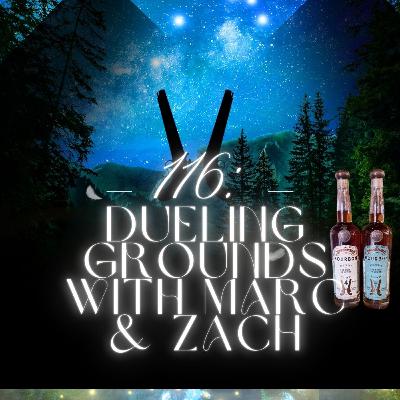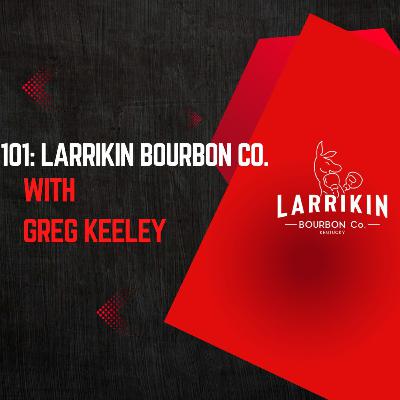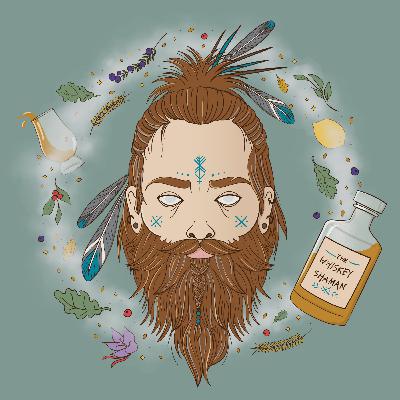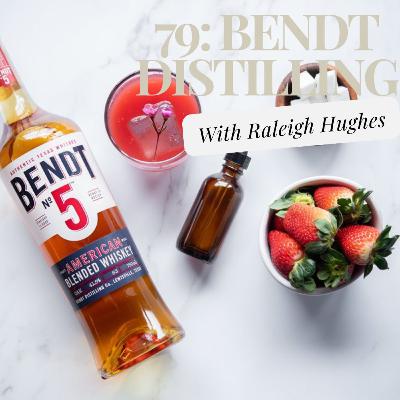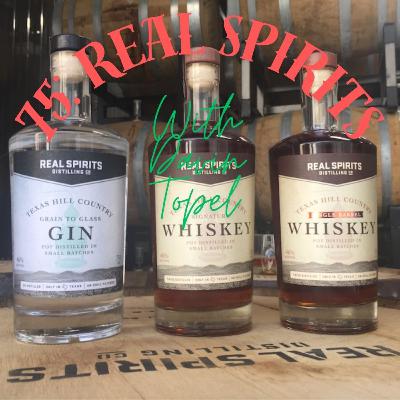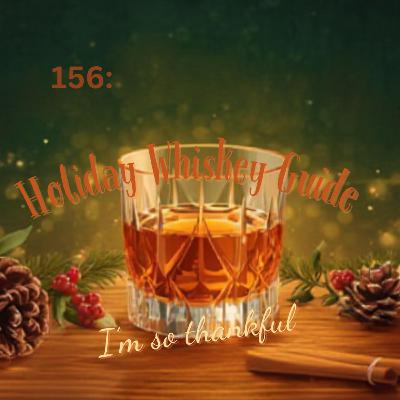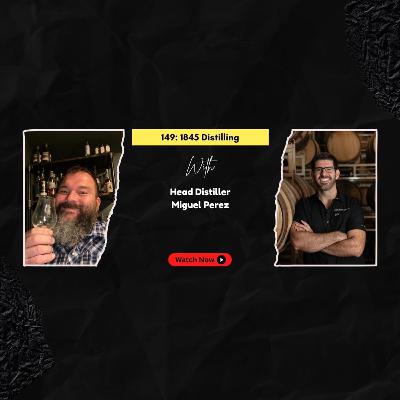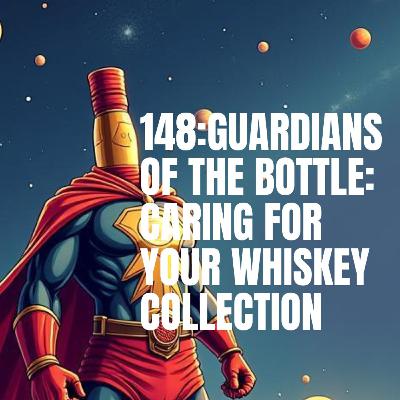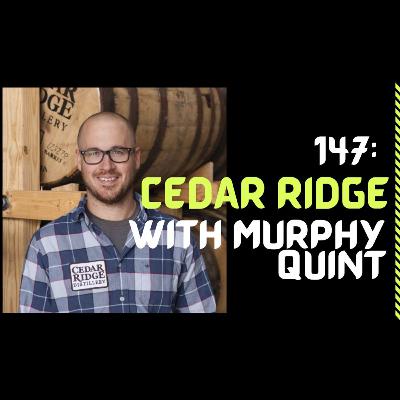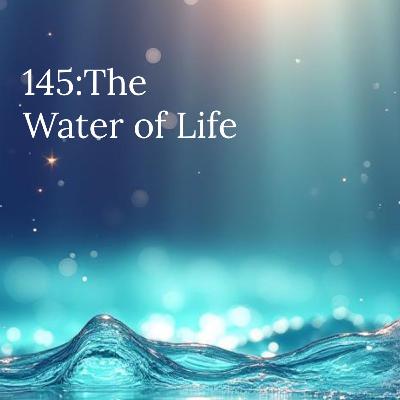Discover The_Whiskey Shaman
The_Whiskey Shaman

160 Episodes
Reverse
WOW is all iI have to say about this one. Such a cool talk with Master Distiller Caitlin, She is a beast for the Clear Creek brand. We talked all things from Brix to fixin tractors. Amazing time, and amazing spirits. Check them out at Clearcreekdistillery.com. or Hrdspirits.com.And don't for get our sponsorsFor the last time this year Texaswhiskeyfestival.comBadmotivatorbarrels.com/shop/?aff=3https://www.instagram.com/zsmithwhiskeyandmixology?utm_source=ig_web_button_share_sheet&igsh=ZDNlZDc0MzIxNw==Patreon.com/the_whiskeyshamanour StoryRooted in Oregon since 1934, Hood River Distillers began by making fruit wines and brandies from the apples and pears that were going to waste as excess production from the valley’s abundant harvests. Located along the Columbia River with majestic Mt. Hood as its backdrop, Hood River Distillers has been at its current bottling facility in Hood River since 1969. The company has expanded the plant for storage and made production line upgrades several times throughout the years. Although our core distribution began in the Pacific Northwest, we are currently producing close to one million cases per year, and distributing our products nationwide.HOOD RIVER DISTILLERS NAMES CAITLIN BARTLEMAY MASTER DISTILLERHood River Distillers, celebrating its 90th anniversary as the Pacific Northwest’s largest and oldest distillery, is proud to announce the promotion of Caitlin Bartlemay to Master Distiller.Bartlemay joined Clear Creek Distillery in 2010 as a logistics coordinator and worked her way through the ranks to distiller. In 2014, Clear Creek was acquired by Hood River Distillers, joining the two oldest operating distilleries in Oregon, and returning Hood River Distillers to its original roots of creating fruit brandies. Bartlemay was named Head Distiller in 2021 and now oversees production of some twenty different distillates including McCarthy’s Oregon Single Malt, the 1st American Single Malt; the award-winning Timberline Vodka; and the renowned Clear Creek brandies and eaux de vie.Bartlemay grew up as a hard-working wheat rancher in Eastern Oregon. Her father started a winery when she was in middle school, and she became fascinated by the science of fermentation. She studied Food Science and Technology at Oregon State University earning her bachelor’s degree in 2010. During her last semester of college, Bartlemay sent letters to every distillery across the Pacific Northwest (at that time there were only 12) inquiring about job opportunities. Steve McCarthy, owner of Clear Creek Distillery, never told her to stop calling, so she didn’t. She started work there the week after graduation.“Caitlin’s vigilant commitment to excellence in every facet of her job is one of the qualities that has made her such an exceptional member of our team,” said David Ballew, President and CEO, Hood River Distillers. “Her passion for quality and craftsmanship is evident in each product that she touches. It’s only fitting that as we celebrate our 90th anniversary, we recognize Caitlin for her leadership in helping Hood River Distillers and its brands continue their heritage of quality in the Pacific Northwest.”“It has been a thrill to be a part of the Clear Creek/Hood River Distillers team and to have had the opportunity to share so many wonderful brands with our customers,” said Bartlemay. “The history of distillation at both Clear Creek Distillery and Hood River Distillers is one that combines pioneering personalities, exceptional products, and phenomenal teamwork. Whether we are continuing the legacy of the first American Single Malt, bottling spirits distilled from the bounty of the Pacific Northwest or creating new custom flavors to celebrate innovation in the whiskey category, I’m proud to lead this next generation of distillers.”
Are you scared yet, well you will be. This is the spooky episode of TWSP and we found some new stories and legends. So sit back and relax, on second thought turn the lights on and grab a bottle. And enjoy after you visit our sponsors.
Badmotivatorbarrels.com/shop/aff=3
https://www.instagram.com/zsmithwhiskeyandmixology?utm_source=ig_web_button_share_sheet&igsh=ZDNlZDc0MzIxNw==
Patreon.com/the_whiskeyshaman
Allow me to regale you instead with the story of the Glenrothes distillery in Scotland. The story actually starts many miles to the south of the town of Rothes, where the distillery is situated, and some years before its construction, by the Firth of Tay at Dundee.
An ambitious construction project to build a rail bridge over a nearly 3 mile-long stretch of the fifth began in 1871. Due to challenges and necessary redesigns, there were significant delays, and the construction was only completed in early 1878, after which the first engine successfully crossed the bridge. Queen Victoria herself used the bridge in June of 1879.
In the same year in which the bridge was completed, the construction of Glenrothes began, and it was not very long until it was ready for production. On the evening of Sunday, 28 December 1879, the first distillation run occurred. On that very same evening, one of the greatest structural disasters in all of the British Isles occurred when a violent storm blew at the precise angles and strength to cause a collapse, just as a train carrying roughly 70 passengers was passing over it. There were no survivors.
Just as the first spirit flowing out of the stills at Glenrothes was being collected, so too did the spirits of those ill-fated travellers depart from this world. Though initially prosperous, the future of Glenrothes would be very turbulent indeed. A fire which raged throughout the distillery 18 years later caused major damage and losses, threatening closure, but they managed to scrape through. Just six years later, in 1903, there was a massive explosion that caused serious damage. In 1922, the second great fire to ravage the distillery burnt down warehouse number 1 and destroyed over 200 000 gallons of maturing whisky. That was not the end of Glenrothes' trial by fire, though, as another significant one occurred in 1962 and prompted the owners to rebuild the damaged structure and also expand the distillery to increase production.
The distillery, by the way, is situated right next to a graveyard. One can't help but think of the staff who worked late shifts throughout the years and caught a glimpse of the tombstones illuminated by the cold glow of a winter moon and reminisced about that tragic day, which some thought to be the cause of all the distillery's woes.
But like an undying spectre, the spirit of Glenrothes has always endured, and they have made and continue to make some good Speyside whisky, though they are quite often overlooked or maybe just regarded as best forgotten, lest some unfortunate series of events be summoned. Better to just let some things lie undisturbed.
Haunted Distilleries: Spirits of a Different Kind
October 31, 2023 –––––– Julia Higgins
Over the centuries, the distilling business has produced famous figures, legends, outright myths, and even ghosts—more than a few of them, in fact. Reports of spectral sightings and other phantom phenomena have occurred so often that they’re almost the rule rather than the exception. Some distilleries have conjured up so much spooky notoriety that paranormal experts have visited, often affirming suspicions that unseen forces are at play. To toast Halloween, we’ve rounded up a handful of distilleries around the world where spirits—the liquid and the otherworldly kind—are both part of the story.
It's finally here. The episode we've been waiting for I finally got Zac Smith on the podcast. And he's accompanied by Mark the head distiller of dueling grounds. This was an excellent episode. I can't wait for y'all to see it and enjoy it.I love that they are doing whiskey their own way and it shows spoiler alert it's pretty good stuff.Make sure you check out our sponsors. And the link to get you a bottle is still active so go tohttps://bit.ly/od-whiskey-shaman. use code whiskeyshaman25 at check outTexaswhiskeyfestival.comBadmotivatorbarrels.com/shop/?aff=3https://www.instagram.com/zsmithwhiskeyandmixology?utm_source=ig_web_button_share_sheet&igsh=ZDNlZDc0MzIxNw==bourbon starts hereWe are a small craft Bourbon Distillery located in Franklin,KY. We are the proud makers of Linkumpinch Bourbon and other craft spirits. Come by for cocktails, whiskey pours, pizza, tours & tastings and to shop our gift shop & bottle shop. The distillery is easily accessible from Exit 6 and Exit 2 on I-65.Our hours are Monday - Saturday 10am - 6pm and Sunday 2pm - 6pm. Check our facebook or call for holiday hours and closings.Get a look at the production process and custom build your flight of mini cocktails and spirits. Tours start at the top of the hour, starting at 11am, Monday - Saturday. The last tour is at 4pm.pizza kitchenWe serve food 7 days a week! Monday - Saturday 11am-6pm and Sunday from 2pm-6pm. Choose a specialty pizza, cheese bread or create your own pizza! Check out our MENU.weekday happy hourStop by for our Weekday Happy Hours Monday - Friday. From 3pm-6pm, get $3 off Cocktails and $1off of Wine & Beer. Enjoy Pizza, Flatbread, Soft Pretzels and Bar Snacks.sip & savor sundayJoin us every weekly from 2pm-6pm for 'Sip & Savor Sunday'. Our mixologist curates a new unique seasonal cocktail menu each week. Enjoy our usual food offerings, along with specialty pizzas and salads.Linkumpinch BourbonThe uniquely handcrafted batches of Dueling Grounds Distillery’s Linkumpinch bourbon are double-pot distilled on site in Simpson County, KY, aged four years in charred oak barrels, featuring corn and wheat from the local area.We are a small team making all of our Bourbon from scratch with local ingredients. We make it, barrel it and bottle it all right here in Simpson County" -distillery Owner/Founder, Marc DottoreTours andTastingsTake a 30-40 minute tour led by the people actually making the distillery’s signature brand, Linkumpinch Bourbon! You will learn about the ingredients and process that make Linkumpinch Bourbon so unique. After the tour, you will head to the Tasting Room to learn about the history of Dueling Grounds and enjoy a tasting of each of our current products. All distillery tours begin in the gift shop. HOURSMonday--Saturday 10am-6pmSunday 2pm-6pmADDRESS208 Harding Rd, Franklin, KY 42134PHONE270-776-9046EMAILduelinggroundsdistillery@gmail.com
Happy New Year, and welcome back. Today we have Greg with Larrikin. This was such a great episode and a great chat, conversation flowed well and was very interesting. Hope you enjoy it, but first a word from our sponsors.
Hinterhausdistilling.com
Badmotivatorbarrels.com/shop/?aff=3
https://www.instagram.com/zsmithwhiskeyandmixology?utm_source=ig_web_button_share_sheet&igsh=ZDNlZDc0MzIxNw==
Patreon.com/the_whiskeyshaman
Live the larrikin Way.
Larrikin (n.) Australian slang. A person who disregards convention; a maverick.
Larrikinism was a reaction to rules imposed by British officials on the young country of Australia. Our whiskey reflects this bold spirit of good-natured irreverence, and relies on character, not ceremony.
You may not know Larrikin the word- but you do know these Larrikins;Annie Oakley, Crocodile Dundee, Johnny Cash, Dolly Parton, Pete Mitchell and Steve Erwin.
We’re greg & katie.
From Lawrenceburg to Larrikin—our name might’ve evolved, but our mission’s still as solid as a rock. Larrikin Bourbon Co. is the true-blue embodiment of the American Dream: a craft distillery built from scratch with a fair dinkum, no-nonsense approach to making bloody good bourbon.
Our founder, LCDR Greg Keeley, USN (ret), has had a wild ride. Greg’s journey kicked off in a vineyard Down Under, to national security professional, and eventually landed in the extraordinary world of distilling. As a Service-Disabled Navy Combat Veteran, Greg has the unique honor of commissioned service in both the United States Navy and the Royal Australian Navy, with combat roles in Iraq, Afghanistan, and the Pacific. Raised in Oz, he also served with the Australian Federal Police.
At Larrikin, we don’t muck around. We’re not here to spin yarns about bourbon dating back to the Pilgrims. Our focus is dead simple: what kind of bourbon do we want in our glass? That’s what gets us out of bed.
Our goal? To craft extraordinary, novel whiskies that we’re stoked to pour and even prouder to share. We bring a bit of Aussie cheek to American whiskey, blending tradition with a whole lot of passion.
So here’s to great bourbon, good mates, and chasing something truly special. Cheers, cobber!
We are LARRIKIN.
BLOODY GOOD BOURBON…and the experts agree.
Private Barrel Program
Our Private Barrel Program is the bee’s knees. Handpicked casks that are as rare as hen’s teeth. Each barrel is a one-of-a-kind gem—unrepeatable and extraordinary.
Simply put, some barrels are just outstanding—first among equals. Choose your barrel in person at the distillery, or remotely, with a curated experience from the comfort of your home, office, or club. Thanks to the new-fangled inter-web, you can taste, evaluate, and select your cask with real-time guidance from our distiller - and find your perfect single barrel select.
Let’s clear the air: we don’t blend our Private Cask selections. We bottle bourbon or rye straight from one single barrel - that you choose. No mucking about. Once it’s bottled, there is no more. Your hand-picked bourbon is one-of-a-kind and impossible to replicate.
Your Larrikin Bourbon Select bottles feature the barrel’s special details like your logo or message along with age, proof, and mash bill. Whether you’re a retailer, distributor, bourbon club, individual with a great taste in bourbon or charity group, your bottles are uniquely yours. Depending on the cask’s age, you’ll get between 140 and 240, 750ml bottles. Rule of thumb, the older the cask, the fewer bottles.
No wait, no drama, just bloody good bourbon.
This is the blind challenge I did with Nora from Lost Lantern. It was a awesome time, check it out.
Babmotivatorbarrels.com/shop/aff=3
https://www.instagram.com/zsmithwhiskeyandmixology?utm_source=ig_web_button_share_sheet&igsh=ZDNlZDc0MzIxNw==
Patreon.com/The_ WhiskeyShaman
Whiskey blinds are a way to taste whiskey without knowing what it is, which helps remove biases and develop your palate. Blind tasting can help you learn to taste the whiskey more objectively, and to rely on your senses to identify its characteristics.
Here are some tips for setting up a blind whiskey tasting:
Arrange bottles randomly: Cover the bottles with numbered sleeves or bags to hide their identities.
Prepare tasting glasses: Provide a tasting glass for each participant.
Have water and palate cleansers: Provide water and palate cleansers for participants.
Bring a notepad and pen: Have a notepad and pen available for taking notes.
You can also buy blind tasting kits, which can include whiskies, instructions, and tasting sheets. Some examples include:
Whiskies of the World: A package that includes four different whiskies, instructions, a tasting sheet, and hints to help you guess which whiskey is which
Blind Barrels: A subscription service that provides four 50 ml samples of American whiskey each quarter, along with a tasting led by a spirits guide
Great Whiskey Challenge: A premium blind taste testing kit that you can use with family and friends
We are back again for round 3. This time we dive into some bourbon stories and lore. We get into Pappygate and a lot of stuff, hope you enjoy.
Badmotivatorbarrels.com/shop/?aff=3
https://www.instagram.com/zsmithwhiskeyandmixology?utm_source=ig_web_button_share_sheet&igsh=ZDNlZDc0MzIxNw==
Patreon.com/the_whiskeyshaman
Whether we’re choosing thousands of barrels to make a batch of our most popular bourbon or picking just a few for a limited release, it takes a lot of veteran employees and a bit of technology to find exactly what we want. Currently, we have over 1.2 million barrels of whiskey aging in 54 rickhouses at six sites throughout Central Kentucky. If you’re thinking that’s a lot of whiskey to monitor, you’re right. But by using computers to track those barrels’ locations, our experienced crews can quickly target the exact ricks where the best whiskeys lie waiting. Technology helps, of course, but when it comes to taste, humans make the decisions at Heaven Hill.
“When we do a bottling run for Evan Williams black label, we’re typically going to dump a few thousand barrels,” says Heaven Hill Distillery Master Distiller Denny Potter. Using proprietary barrel inventory control software (known to us as “BIC”), Denny starts the search for 5- to 6-year-old barrels of our bourbon rye mashbill. And while he could select that number of barrels from within any of our 20,000-plus barrel rickhouses, he never pulls the entire lot from just one.
“We spread what we choose out across multiple warehouses, because you get so much variation in flavor from different warehouses and even warehouse sites,” he says. “For Evan Williams black, we like to take a cross-section of those barrels from three to four sites because we’re mingling the whiskey in those barrels to create a consistent flavor profile. “If we pulled all of the barrels out of our Deatsville location at one time, and pulled just from a Bardstown warehouse the next, every batch of that whiskey would taste different.”
BIC is also used to identify each barrel’s specific location in every rickhouse. If located on the highest floors, where Kentucky summers heat the air to 115 degrees, water evaporates from the whiskey and boosts its alcohol content well above its initial 125 proof at barreling. By contrast, barrels resting on lower levels can see proof decrease. There, in the damp coolness of the rickhouse, water stays behind while some of the alcohol evaporates. Barrels in the middle levels, as you might expect, yield a balance of water, alcohol and flavors from the wood.
Recently, Denny let a small group of guests taste these weather-influenced changes for themselves by sampling barrels from multiple rickhouses and locations. One bourbon came from the first floor, another from a middle floor, and another six stories up near the ceiling.
“The one from the sixth floor was 150 proof, while the whiskey from the bottom floor was 99-a 51 proof difference!” Denny says. “That 99 proof was a 16-year-old wheated bourbon, and I’m telling you, it was one of the best whiskies I’ve ever had. The 150 proof was really good, but really hot.”
Barrels chosen for our small batch whiskeys are more tightly scrutinized-first by experienced individuals looking through BIC, then by our onsite crews. An Elijah Craig or Larceny hunt will cull out 200 barrels or less to be dumped and mingled. For Henry McKenna 10-Year-Old Bottled-In-Bond, about 30 barrels are identified and segregated as single barrels, without batching, from rickhouse to bottle. With batches ranging from two to 200 barrels, the need to have their actual flavor sampled by tasting panels increases.
“It’s tougher to blend less whiskey to achieve the final flavor you want when the dump is that small,” Denny says. “Say it’s part of our Parker’s Heritage Collection, a 24-year Bottled-in-Bond, the number of barrels we choose for that is a really small amount, and every barrel is sampled.”
Heavenhilldistillery.com
Welcome back guys this was a lot of fun. Today we have Raleigh Hughes the sales lead for Bendt. We talked backstory, we talked process, we talked submarine stills. Use the coupon code GETBENDT24 to get a discount ot there website Bendtdistillingco.com And now a word from our sponsors
Badmotivatorbarrels.com/shop/?aff=3
https://www.instagram.com/zsmithwhiskeyandmixology?utm_source=ig_web_button_share_sheet&igsh=ZDNlZDc0MzIxNw==
A native Texan, Raleigh loves golfing, Dallas sports, and sipping cocktails under the big Texas sky. He learned to golf from his grandfather, and actually spent some time playing professionally. He enjoys hanging out on local patios with his pup, Maggie, and spending time with his family. Raleigh joined #teambendt in March 2020.
How does Raleigh #getbendt? BENDT + Lemonade
2011
Before the distillery was born, the DeHarts were homebrewing up a storm in their Dallas home, and Quentin Witherspoon was making rum on the side. A chance visit to Dallas by a mutual US Marine Corps friend of Ryan & Quentin brought the original partners together, and after a night of drinking whiskey and plotting an exciting venture into craft distilling,a plan was formed.
2012
A warehouse was leased, permits were applied for, and a still was being built by hand. And Witherspoon Distillery had become a party of four - Quentin Witherspoon, Ryan DeHart, Natasha DeHart and Laurent Spamer formed the founding management, production, sales and marketing teams. By late summer 2012, Witherspoon Distillery was approved as a fully legal and operational craft distillery. The learning process had begun, a small distributor was on board, and Quentin’s River Rum was making its way into the market. Before long, the crew discovered what would become a never-ending issue - growth in the distilling industry comes with a need for space. And whatever space you think you need, you’ll need significantly more by next year.
2013
Distillery intern Christy Cockrell became the first of several additions to the WD team in the summer of 2013. Little did we know at the time that her project, a grain-to-glass malt whiskey that was later branded as “Cross Timbers”, would eventually alter the direction of the distillery from rum to whiskey.
On September 1, 2013, Texas law changed to allow distillers to pour samples, and on a limited basis, sell cocktails and bottles directly to consumers. That week was spent constructing a bar from fencing remnants, creating a limited cocktail menu, and inviting friends and family for the first ever Witherspoon Distillery tour. On Saturday, September 7th, the first distillery tour took place, the Maple Old Fashioned and Hemingway cocktails were served, and the first official guests visited.
Got a good one for yall today. We got Davin Topel from Real Spirits, and we have a great conversation about life, whiskey, real estate. Hope you enjoy
Badmotivatorbarrels.com/shop/?aff=3
https://www.instagram.com/zsmithwhiskeyandmixology?utm_source=ig_web_button_share_sheet&igsh=ZDNlZDc0MzIxNw==
Patreon.com/the_whiskeyshaman
From Grain to Glass:The Real Spirits Way
Real Spirits emerged from deep roots of craft brewing in the Texas Hill Country.
After 21 years of building a solid foundation of beer, we launched the Real Spirits Distilling program in 2017. Our owner, Brad Farbstein, is as passionate about unique handmade spirits as he has always been about craft beer. In October 2014 he filed for a distillery permit and began tinkering away to create what would become Real Spirits. In April 2017, after years of experimentation and fine-tuning, we launched Real Spirits to the public out of our tap room with Texas Hill Country Signature Whiskey, Grain to Glass Gin, and the highly limited first batch of Single Barrel Whiskey.
See Our Spirits
It starts with beer
All Real Spirits starts with – of course – a foundation of Real Ale beer. Currently, Real Ale’s Devil’s Backbone Belgian-style Tripel and the award-winning Real Heavy Scotch Ale are used to make our signature and single barrel whiskey, and White, a Belgian-style wheat ale, is the base beer for our gin. This means we make all Real Spirits liquors grain-to-glass. They are brewed, fermented, aged, bottled, and served on-site at the brewery and distillery in Blanco.
Distilling the good stuff
Real Spirit’s whiskey process begins as any other day at the brewery. Our brewers brew beer for distilling the way they normally would. The only difference is that they forgo the addition of hops during the brewing stage. This is then fermented to about an 8% ABV beer. Our distiller fills the 1100 liter hand-hammered copper pot still with the beer and brings it to the boiling point of ethanol (around 170F degrees). The steam that is generated is then pushed through the lyne arm into the condenser where it is introduced to a cold environment, turning the steam back into a liquid. This liquid is cut into three portions, heads, hearts and tails (beginning, middle, and end of the distillation). Only the hearts are collected and barreled for a determined period of time. As the whiskey ages, we taste each barrel and determine when the spirit has matured. Finally, the spirit is harvested from each barrel and mingled together for bottling.
Whiskey Sour
A whiskey sour is yours for the making year-round. It’s refreshing enough to keep up with a spritz during the warm summer months, but appropriate during the colder seasons of the year as well.
Ingredients
2 oz. Real Spirits Texas Hill Country Whiskey
Juice from 1 lemon
1 1/2 tsp agave nectar
Cherry
Lemon wedge
cocktail glass
ice
Directions
Pour Signature whiskey into a shaker of ice.
Add lemon juice and agave necatar
Shake lightly
Strain into a cocktail glass full of ice.
Garnish with a cherry and lemon wedge
Enjoy!
Ginger’d Ass
Finish with the ginger beer of your choice. We like Maine Root Ginger Brew.
Ingredients
2 oz. Real Spirits Texas Hill Country Whiskey
1 sprig of rosemary
1 lime wedge
ginger beer
cocktail glass
ice
Directions
Pour Signature whiskey into a shaker of ice.
Add rosemary and lime wedge
Shake well.
Strain into a cocktail glass full of ice.
Top with ginger beer.
Enjoy.
So we start with a blind, as we should. Then the wheels fall off, like always. Don't get it twisted this is a banger. It once again doesn't follow the algo. Hope you enjoy??!!Thewhiskeyshaman.comBadmotivatorbarrel.com/shop/?aff=3https://www.instagram.com/zsmithwhiskeyandmixology?utm_source=ig_web_button_share_sheet&igsh=ZDNlZDc0MzIxNw==A good holiday whiskey guide offers recommendations based on the recipient's palate, price range, and the type of whiskey (Bourbon, Scotch, Rye, Irish, etc.) they enjoy. Top recommendations for the holiday season often include approachable, high-quality bottles as well as unique or rare finds. For the Beginner or Casual DrinkerIf the recipient is new to whiskey, opt for a smooth, balanced, and versatile option that can be enjoyed neat, on the rocks, or in a cocktail. Bourbon: Buffalo Trace or Four Roses Small Batch are widely available and well-regarded, offering classic notes of caramel and vanilla without being too overwhelming.Irish Whiskey: Jameson or Redbreast 12 Year are excellent choices known for their exceptional smoothness due to triple distillation and balanced flavor profiles.Scotch (Unpeated): Glenlivet 12 Year or Glenfiddich 12 Year are classic, approachable single malts with fruit and malt flavors, serving as a solid introduction to the category. For the Enthusiast or ConnoisseurFor someone with a more developed palate, look for single barrel, cask strength, or age-stated bottles that offer complexity and unique flavor profiles. Bourbon: Elijah Craig Barrel Proof offers rich caramel, vanilla, and oak flavors, while Blanton's Single Barrel is a highly sought-after and collectible option.Rye Whiskey: Wild Turkey Rare Breed provides a high-ABV, complex experience with notes of spice and oak. A quality single barrel store pick of Knob Creek Rye is also a great option.Scotch (Peated): For those who enjoy a smoky flavor, Ardbeg Corryvreckan provides an intense maritime peat experience, or a more subtle introduction can be found with Bowmore 15 Year.Unique Finds: Japanese whiskies like Hibiki Japanese Harmony are elegant blends that offer a different profile of honey, orange peel, and oak. Beyond the BottleYou can also enhance the whiskey-drinking experience with complementary gifts: High-quality glassware: Glencairn glasses are specifically designed to enhance the aroma and tasting experience.Whiskey-themed accessories: Consider a decanter, sphere-shaped ice molds, a cocktail smoker, or a relevant book like The Bourbon Bible.Gourmet pairings: Bourbon barrel-aged maple syrup or a set of Woodford Reserve bourbon balls make for a tasty, themedBeyond a bottle of whiskey, great gifts for a whiskey lover include high-quality glassware and decanters, tasting accessories like whiskey stones and cocktail smoking kits, educational books, and food pairings.Glassware & BarwareUpgrading their bar setup enhances the entire whiskey experience.Glencairn Glasses: These are the official tasting glasses used by distilleries because their unique, tulip shape is designed to concentrate and funnel the whiskey's aromas to the nose, maximizing the tasting experience.Heavy Tumblers (Rocks Glasses): Essential for enjoying whiskey on the rocks or in cocktails like an Old Fashioned. Look for quality crystal glasses that have a satisfying weight and feel in the hand.Decanter: A stylish, airtight decanter provides an elegant way to store and display their favorite spirit, turning a simple pour into a ritual and becoming a beautiful statement piece for their home bar.Specialty Ice Molds: Large square or sphere-shaped ice molds are highly useful as they melt slowly, chilling the drink without diluting the complex flavors as quickly as regular ice cubes.20 Unique Gifts for Whiskey Lovers (Not Just a Bottle)Oct 27, 2025 — Table of Contents For WordPress Implementation: Key Takeaways. * What Makes a Great Whiskey Gift? Focus on Quality...
Well I can quit for the year now. (Just wait we aint done yet). Today we have Ana with Westland. We chatted about it all Beginnings and 5 malts. The road there and back again. Can't wait for yall to watch/listen. Enjoy!!Thewhiskeyshaman.comWestlanddistillery.comPatreon.com/the_whiskeyshamanBadmotivatorbarrels.com/shop/?aff=3https://www.instagram.com/zsmithwhiskeyandmixology?utm_source=ig_web_button_share_sheet&igsh=ZDNlZDc0MzIxNw==it begins with an ideaIn whiskey itself, as a discipline, we do not see a fully explored, mature world, as most in our industry do. We see the opposite. For us, whiskey is not a feature of this world that is ours to protect, it is an extension of ourselves that is ours to advance when the opportunity presents itself. And the opportunities are vast, maybe incalculable. Each bottle of whiskey we fill at Westland represents one step forward in sharing the story of our place. Ten years have passed, and we have circled the topic of terroir again and again, each time sensing an opportunity to approach it from a new perspective. But always, we’re heading west.Westland Whiskey started in 2011 with a great vision to create American Single Malt whiskey that reflects the true colors of the Pacific Northwest region. Over ten years later, we continue to fill casks with single malt whiskey that we distill in Seattle's SoDo neighborhood and age mindfully in Washington State's Skagit Valley region.We are proud to be seen as one of America's premiere distillers with sustainable practices and award-winning spirits. We love hearing from you; contact us if you have any questions about Westland.Whiskey$59.99Westland's signature American Single Malt Whiskey is a culmination of over 10 years pioneering a new category of whiskey that has put America on the global single malt map. This latest expression represents the possibilities to be explored in single malt and captures the essence of our house style in one flagship bottle.Garryana 10th Edition - Aged 10 YearsA Decade of PursuitOur exploration of Garryana began with purpose and curiosity in November of 2011. It was with that first cask that we saw the massive potential of our native oak, not just for its incredible flavor profile, but for its ability to distinguish, in a palpable way, the unique character of our Pacific Northwest terroir. Since 2011, we’ve been waiting for the opportunity to showcase the qualities of our native oak in a new way, and to honor Garryana with the reverence and patience it deserves. Westland is releasing, for the first time, an age-stated whiskey, Garryana, Aged 10 years. The result of years of dedicated effort and the beginning of a new chapter for Westland, as we continue to explore the unique qualities of our Pacific Northwest home. We hope you enjoy the journey as much as we have.Product Specs: Maturation Time: 10 yearsABV: 50% ABV // 100 Proof Grain Bill: Westland Signature Five Malt + Washington Pale Malts Primary Casks: First & Second Fill Garry Oak Secondary Casks: Pedro Ximenez Hogshead, Rum, and Ex-Bourbon Nose: Mulled Wine, Clove, Walnut Fudge Brownie, and Lemon Danish PastryPalate: S’mores, Dehydrated Strawberry, Toasted Cumin, Blood Orange
So this is something new i thought I would try. I really hope you enjoy. A deep dive of Gold Finch, the in's and out's. We get into Canadian Whisky, Sauternes and Quadrants.Foundnorthwhisky.comThewhiskeyshaman.comBadmotivatorbarrels.com/shop/?aff=3https://www.instagram.com/zsmithwhiskeyandmixology?utm_source=ig_web_button_share_sheet&igsh=ZDNlZDc0MzIxNw==Patreon.com/the_whiskeyshamanAt Found North, we make blended Canadian whisky for whisky enthusiasts. We work with Canadian distilleries to source well-aged, well-made distillates, which we further mature and blend in the U.S. We are extremely meticulous in our wood selection and aging process, our blending process and all of the important details that impact the quality of the whisky. Every Found North release is cask strength with no additives or chill filtration.Each year, we release 1-2 Batches and 1-2 High Altitude Collection whiskies. We also release 1-2 whiskies exclusively for our mailing list. At present, all of our releases sell out immediately, so we use a lottery system. Like our whisky-making process, we try to be as thoughtful as possible about how we get our whisky to our supporters. If you participate consistently, you will get bottles of Found North.We love what we do. We’re thankful to all of you for appreciating the way we make whisky so that we can keep exploring the boundaries of what Canadian whisky can be.Each batch of Found North whisky is a careful selection of casks blended to bring out the best and most distinctive qualities of the chosen whiskies. Every release is unique, but each also builds on previous batches and fits into the unfolding saga of Found North. All our whiskies are non-chill filtered with no coloring or additives. Batch 001 and Batch 002 were released in April 2021 and both received Double Gold at the San Francisco World Spirits Competition. Batch 003 was awarded Double Gold and Batch 004 won "Best Canadian Whisky" and was awarded Double Gold at the John Barleycorn Awards Spring 2022.Double Gold (San Francisco World Spirits Competition 2021)Batch 001 is a 3-whisky blend that started with an herbaceous, feisty and deeply flavorful 16 year old rye aged in Hungarian oak. We blended in fruit-forward, 17 year old rye aged in ex-Speyside scotch casks. The combination revealed a smoldering symphony of spice. Last, we lengthened the finish and increased the viscosity by adding double-distilled corn whisky aged for 20 years in refill and level-2-char virgin oak.Batch 001 is defined by its spice profile. The first impression is hot cinnamon and cayenne mixed with earthy jalapeno, black pepper and peppermint. The second pass presents lively and herbaceous spices of green tea, basil and bay leaves. While the initial profile is all spice, there are layers of fruit and butterscotch lying in wait, especially in the mid-palate, including red fruits, blackberry, apple and sweet melon. The finish walks an endless tightrope with dry spice on one side and chewy tannins on the other.We created Batch 001 in order to demonstrate the dynamism of aged rye and shatter the misconception that rye shows its best spice profile when bottled young. That said, rye spice is a double-edged sword. The deeper we cut into the flavor opportunities, the spicier the palate. You can try to smooth the spice out with new oak or water it down through proofing. Batch 001 exemplifies the third option -- forget about making it “smooth” and instead make the whisky as robust and multifaceted as possible while finding the careful balance between astringency and tannin.
We are headed back to a familiar place. Pennsylvania, it calls me back again. Jim over at Liberty Pole is producing some great stuff. And it shows not only in flavor but also in passion. I really hope you enjoy.Thewhiskeyshaman.comLibertypolespirits.comBadmotivatorbarrels.com/shop/?aff=3https://www.instagram.com/zsmithwhiskeyandmixology?utm_source=ig_web_button_share_sheet&igsh=ZDNlZDc0MzIxNw==Patreon.com/the_whiskeyshamanAbout the HoughsLiberty Pole Spirits is a family owned and operated craft whiskey distillery started by Jim, Ellen, Rob and Kevin Hough in July 2016. The Houghs, longtime residents of Washington County, Pennsylvania got the distilling bug in the early 2000's when Jim bought a 10 gallon still off the interwebs to learn the art of distilling. As Jim was contemplating retirement he began to think about what he could do for a second act. After visiting numerous craft distilleries and having developed some pretty solid whiskey mash bills, Jim was able to convince Ellen that opening a craft whiskey distillery just might be a fun retirement activity. Rob and Kevin, both mechanical engineering graduates who were on their own promising career paths, decided they didn't want their parents to have all the fun and joined the family business. With Rob and Kevin running production, Ellen creating the best craft cocktail and whiskey experience this side of Kentucky, and Jim greeting customers and talking whiskey in the tasting room, Liberty Pole Spirits was born.The distillery started as a 300 gallon operation and expanded to a 600 gallon operation in 2019 and moved to a distillery campus in July of 2023 where we were able to triple our production.Our StoryIn 1791, Washington County, Pennsylvania, was a heavily wooded wilderness at the headwaters of the Ohio River. Many Scotch-Irish veterans of the Revolutionary War had returned to the area and the rocky farms that they had established before the War. They struggled against the weather and disease, and being far from the East Coast, enjoyed few luxuries.But through the rugged ingenuity of the brave Colonists, one of the first American Industries was born. Whiskey. For years, the grain that wasn't consumed was preserved in the form of distilled spirits. It was safer to drink than contaminated water, eased pain and suffering, and improved the spirits of friends and neighbors. It was easy to ship over the mountains in barrels on backs of mules or down the Ohio River to the Mississippi and up the coast to Boston.It was then that the government of our new nation saw the opportunity, through the imposition of an excise tax on whiskey, to pay off the debts owed to the allies who had helped to win independence from tyranny. Yet, the farmers of Washington County were struggling mightily to keep their land and grow crops. Having no cash, they used their whiskey to barter for goods and supplies that they needed for daily life. Whiskey-making provided their best chance to survive. This is why they saw the tax as an imposition of an arrogant, out-of-touch, new government.So they gathered together secretly in a meetinghouse near Mingo Creek and vowed not to pay the tax. They were the first men to oppose an act of the new government, and they vowed to stick together. They called themselves the Mingo Creek Society.As a symbol of their unity, they planted Liberty Poles throughout the county.Years later, the stories of their defiance are preserved in museums, churches and cemeteries around the county.Now, heritage grain once again grows in the same soil they so dearly loved, travels down the paved paths upon which they drove the whiskey-laden mule trains, and arrives at the new Mingo Creek Meetinghouse where it is distilled and enjoyed by the next generation of the Mingo Creek Society.And this time, the Liberty Pole is displayed on the label of each whiskey bottle and symbolizes the loving appreciation for a craft that once again is bringing livelihood to a proud community.
Have you ever picked up a bottle, paid top dollar for it, got it home and MEH. Or you buy it, get in the truck and have instant regret. We talk all about that and get a couple of listener write ins. Hope this episode is enjoyable.Thewhiskeyshaman.comPatreon.com/the_whiskeyshamanBadmotivatorbarrels.com/shop/?aff=3https://www.instagram.com/zsmithwhiskeyandmixology?utm_source=ig_web_button_share_sheet&igsh=ZDNlZDc0MzIxNw==Whiskey buying remorse is a specific type of buyer's remorse, which is the feeling of regret, anxiety, or guilt that occurs after making a purchase. In the context of whiskey, this feeling is triggered by a variety of factors related to the characteristics of a bottle, the price, and the purchasing experience. Common reasons for whiskey buying remorseDidn't meet expectations: This is a major cause of regret for whiskey drinkers. You may have bought a bottle that had received glowing reviews, but once you try it, the flavor profile doesn't live up to the hype.Overpaying for a bottle: With the high demand for certain whiskies, prices can become inflated. Remorse often sets in when a drinker feels they paid a premium for a bottle that doesn't offer a quality-to-price ratio that they can justify.Buying on a whim: An impulse purchase can lead to regret, especially when you haven't had a chance to taste the whiskey beforehand. This is a riskier strategy than sticking to a tried-and-true favorite or a bottle you've previously sampled.Discovering it's not a good fit: Some whiskies, despite being well-regarded, may not suit your personal taste. You may find you simply don't enjoy the flavor profile, leaving you with a bottle you struggle to finish.Hoarding instead of drinking: Some collectors experience remorse when they realize they're accumulating bottles without enjoying them. The point of buying whiskey is to drink it, and if it becomes just another museum piece, the purchase can feel pointless. Whisk(e)y purchases that you regret? : r/whiskey - RedditApr 14, 2021 — Anyone who doesn't have a strict, “Don't buy it unless you've tried it.” rule probably has at least one regret. I know...RedditExpensive bourbons for sale: Some rare bottles aren't worth ...Jul 8, 2019 — I've never been good at science, and despite an abundance of education on all things whiskey, I can't tell you what mak...The Courier-Journal·Dana McMahanHow to avoid whiskey buying remorseTaste before you buy: This is the most effective way to prevent remorse. If you can, try a sample at a bar or with a friend before committing to a full bottle.Research thoroughly: Before making a purchase, especially a costly one, read a variety of reviews and opinions from different sources. Don't rely on just one person's assessment.Set a budget: Establish a spending limit and stick to it. This can prevent the regret that comes with overspending on an expensive bottle.Identify your triggers: Pay attention to what makes you make impulsive purchases, such as a flashy marketing campaign or an enticing sale. Recognize these triggers and avoid them.Ask for help: If you're unsure, ask knowledgeable staff at a liquor store for a recommendation based on your preferences. Working with an expert can help guide you toward a satisfying choice. In addition to not meeting expectations, overpaying, or buying on a whim, people experience whiskey buying remorse for other reasons related to taste, collector pressure, and disappointment with specific characteristics. Disappointment with the tasteUnpleasant or off-tasting flavor: Sometimes a whiskey has a genuinely bad or unpleasant taste that makes it difficult to drink. This can include flavors that taste "medicinal" or "funky".Too much oak influence: While age is often associated with quality, older whiskeys can sometimes have an overpowering "woody" or oak flavor that masks other notes.
Today we are headed to Ireland. Crossing the pond is a big step for this show. And it shows in the blessing that is Shane McCarthy. Amazing talk and the whisky isnt bad either. Hope you enjoy.Twostackswhiskey.comthewhiskeyshaman.comBadmotivatorbarrel.com/shop/?aff=3https://www.instagram.com/zsmithwhiskeyandmixology?utm_source=ig_web_button_share_sheet&igsh=ZDNlZDc0MzIxNw==Patreon.com/the_whiskeyshamanTwo Stacks Signature Blend 43% ABVSuits: The whiskey novice or those looking to explore alternative Irish whiskey styles.A good all-rounder. Approachable & versatile.This modern Irish blend revives the art of whiskey bonding, combining grain, malt, and pot still whiskey for an ultra-smooth, versatile spirit - ideal for sipping or mixing.Simple Tasting NotesNose: Honey, vanilla, toasted oak, and a touch of citrusPalate: Smooth and balanced with caramel, spice, and dried fruitFinish: Light, clean, and slightly sweetMore about the pour:For many decades, blended Irish whiskey was little more than an afterthought - a high-volume, low-cost product with uniform characteristics: the same ABV, taste, and finish, all derived from the same base spirit.The First Cut was inspired by a desire to transform this perception and craft a blend with true distinction. This unique combination highlights a diverse range of matured spirits, making it a trailblazer in the category. Renowned for its robust and approachable profile, it was also the first Irish whiskey available in a can, breaking new ground in the industry.Why not try – The Classic Two Stacks Signature HighballIngredients:50ml Two Stacks Signature Blend150ml Soda Water or GingerLemon Peel GarnishMethod:Fill a highball glass with ice.Pour in whiskey and top with soda.Stir gently and garnish with a lemon peel.Glassware: Highball GlassIreland once had a rich history of cask bonding. A key lifeblood to the industry, where many towns and cities across the country had family ran businesses, big and small operating as bonders, grocers and merchants.Yes we can... Bringing you Whiskey on the move!The Two Stacks — Dram in a Can is the world’s first Irish whiskey in a can, serving the same great flavour profile and focus on quality spirit as the rest of our family of whiskey. Perfect for on the move, out with friends or even just a solo dram in the great outdoors. Enjoy your Dram the way you want!SustainabilityOur focus on eco-friendly practices is not just a commitment; it is a reflection of our broader vision. Through sustainable operations and conscious choices in every aspect of our product, TWO Stacks Irish Whiskey aspires to set a standard for responsible business practices within the spirits communityTwo Stacks is part of a new and adventurous chapter in Irish whiskey, and we want you to help us tell its tale!Ireland once had a rich history of cask bonding. A key lifeblood to the industry, where many towns and cities across the country had family ran businesses, big and small operating as bonders, grocers and merchants. Purchasing directly from established distilleries, the casks were left to mature before its subsequent bottling under the respective owner’s own label.With the demise of the Irish whiskey industry in the early 20th century, only a handful of these great brands have survived to this day, and with it, the light that shines on this tradition was nearly extinguished for good.
Finding a Brand to stand behind is hard. But in a family business, its even harder. Miguel Perez Head Distiller of 1845 Distilling In Mc Kinney Texas, is changing the way a family business is run. We talk all about there brand and story. Get into life and keeping the whiskey magic alive. I really hope you enjoy this episode, because I sure did.Thewhiskeyshaman.com1845distilling.comBadmotivatorbarrels.com/shop/?aff=3https://www.instagram.com/zsmithwhiskeyandmixology?utm_source=ig_web_button_share_sheet&igsh=MWZ4dGp2MzlucjVvdw==Our experience with fermentation started back in 2008 when Bob and June opened the Port Aransas Brewing Company in Port Aransas, Texas. They specialized in brewing craft beers for eager beachgoers. They eventually brought on Miguel, who was in culinary school at the time, to help with brewing.After selling the brewpub and relocating back to their hometown of Dallas, Bob and June planted their roots in Lowry Crossing and decided to take the next step, and open a distillery. They brought Miguel on as the lead distiller and sought education from distilleries and schools all over the country. We began perfecting our grain to glass process, and in 2019, we barreled the first of close to 600 barrels currently in the barrel barn. Once those first barrels became 3 years old, we started blending, bottling, and preparing to open our tasting room. After submitting bottles to close to 6 competitions in 2023, we were stunned when we medalled at all of them. We opened our tasting room doors in February of 2023 with an overwhelming amount of local support.certified texafied preemption Between 1846 - 1898 the State of Texas continued issuing preemption grants to early Texas settlers. In 1860, the ancestors of our Distiller received their preemption grant from the State of Texas. His family still owns the original homestead. Many relatives have been born on that property. His Grandmother, now in her 90’s, still lives on that land and operates the Family ranch. With the birth of the next generation, their roots are now eight generations Texas strong.Our Preemption Texas Straight Bourbon pays homage to the Republic of Texas and its settlers. Our first bottling of the Preemption Texas Straight Bourbon was released in Spring 2022.
Thank you so much to Patreon Supporter KARL. He suggested this topic. So You are getting some bottles, and you cant drink them fast enough (or you shouldn't). What do you do with them. How fast do they oxidize. How do i store them. All questions answered, if you're ready ready let's get into it.Thewhiskeyshaman.comPatreon.com/the_whiskeyshamanBadmotivatorbarrels.com/shop/?aff=3https://www.instagram.com/zsmithwhiskeyandmixology?utm_source=ig_web_button_share_sheet&igsh=MWZ4dGp2MzlucjVvdw==Storing and protecting your whiskey collectionTo protect your whiskey collection and preserve its value, proper storage and care are essential. Storage environmentKeep bottles upright unlike wine, whiskey should always be stored vertically to prevent the high alcohol content from degrading the cork over time.Store in a cool, dark place away from direct sunlight, which can alter the whiskey's color and flavor profile.Maintain a consistent temperature between 59-68°F (15-20°C), avoiding fluctuations that can damage corks and degrade flavor.Control humidity levels between 50-70% to prevent corks from drying out (which can lead to oxidation) and to protect labels and packaging from damage.Avoid basements with excessive humidity, garages, or attics, which are prone to temperature and humidity fluctuations. Cork care and air exposureEnsure seals are tight on bottles to prevent evaporation and oxidation.Tilt bottles briefly every few months (about 10 seconds) to moisten corks without prolonged contact with the whiskey.For opened bottles, transfer whiskey to smaller, airtight containers to minimize air exposure and slow oxidation. Protecting bottles and labelsMinimize handling to avoid smudging or damaging labels.Store bottles in their original boxes or cartons for added protection against light and humidity.Use protective sleeves or covers for rare labels.Consider a secure whisky storage facility, climate-controlled cabinet, or safe, especially for valuable bottles. Control air exposure The single most important factor for an opened bottle is the amount of air inside. Oxygen reacts with the whiskey, slowly altering its flavor. Transfer to a smaller bottle: If a bottle is less than half full and you don't plan to drink it quickly, pour the remaining whiskey into a smaller glass bottle with a tight-sealing lid. This dramatically reduces the surface area exposed to oxygen.Use an inert gas: For a more advanced solution, use a wine or spirit preserver system that injects an inert gas (like argon) into the bottle. This heavier-than-air gas creates a protective layer over the whiskey, shielding it from oxygen.Keep a tight seal: Always ensure the bottle is tightly sealed after each pour. If the original cork is deteriorating, replace it with a clean, well-fitting stopper. How to Store WhiskeyHow to Store Whiskey * Preserving Your Whiskey's Flavor. Unlike wine, whiskey's flavor doesn't change once it's bottled. And, unlike wine, a bottle of whiskey d...Jameson Irish WhiskeyWhisky & Oxidation | WhiskipediaAug 6, 2020 — A certain Welsh whisky is becoming so well known among enthusasts for its transformation that we know drinkers who will deliberately decant the bottle to maximi...whiskipedia.comManage environmental factorsThe best practices for unopened bottles still apply, but are even more crucial for opened ones. Keep it in the dark: Store open bottles away from direct sunlight, which can fade both the whiskey's color and the label. A dark cabinet or closet is ideal.Maintain a consistent temperature: Avoid temperature fluctuations by storing your whiskey in a cool, stable environment, typically between 59–68°F (15–20°C). Avoid basements with excessive humidity, garages, or attics.Store bottles upright: Always store whiskey bottles upright to prevent the high-alcohol liquid from degrading the cork and potentially contaminating the spirit with cork bits.
So there comes a time when a conversation turns to a movement. And I believe we might have started something. Today we have Murphy Qunit Head Distiller of Cedar Ridge Distilling. We talked everything Iowa and whiskey and life. Hope you enjoy.Thewhiskeyshaman.comPatreon.com/the_whiskeyshamanBadmotivatorbarrels.com/shop/?aff=3https://www.instagram.com/zsmithwhiskeyandmixology?utm_source=ig_web_button_share_sheet&igsh=MWZ4dGp2MzlucjVvdw==Cedarridgedistillery.comThe Quint family has farmed and distilled spirits for generations. In 2005, Jeff Quint founded Cedar Ridge because he believed it was time for Iowa–the number one corn-producing state in the U.S.–to share its homegrown Bourbon Whiskey with the world. Cedar Ridge was the first licensed distillery in Iowa since Prohibition.After releasing its first batch of whiskey in 2010, Cedar Ridge Distillery quickly became a nationally recognized leader in craft spirits, winning multiple awards such as American Distilling Institute’s “2017 Distiller of the Year” or “Best American Craft Whiskey” at the 2016 New York World Spirits Competition.From our American Single Malt to our Iowa Bourbon, each bottle of Cedar Ridge whiskey offers the best of authentic Iowa craftsmanship.Iowa is home to the most fertile soil in the world. We’re proud of our reputation as a farming state. Local access to the highest-quality corn on earth helps us craft the finest bourbon you can find.Explore our product pages to learn all that goes into making each Cedar Ridge whiskey.Managing every step of production, from grain to glass, is how you craft authentic whiskey. Our process is unique, affected by our specific location and even weather. You won’t find the Cedar Ridge taste anywhere else in the world. Below is an overview of what goes into making each sip special.We store and mill our corn and grain on-site. Our initial bourbon batches were made using corn grown on our own family farm in Winthrop, Iowa – and while we’ve outgrown what the family farm can grow we are dedicated to using only Iowa Corn. Lautering our mash separates the liquid wort and spent grain. The wort is then fermented and distilled, while the spent grain is hauled off as animal feed for local farmers. Twice distilling our whiskeys to a higher proof, and removing the impurities results in a more approachable sipping whiskey. Allowing nature to be our ultimate guide in aging, we transfer the whiskey to barrels, and store them in non-temperature controlled rick houses. Iowa’s consistently inconsistent weather aids in the expansion and contraction of the barrels, allowing the whiskey to take on the rich aromas and flavors more quickly than in other regions. This being said, Mother Nature takes her cut – at a rate of 18% vs. the industry standard of 12%.Take a look back at how we started making whiskey in Iowa. While we’ve outgrown what the family farm can produce we remain always dedicated to using only Iowa Corn.
Not gonna lie, this could be one of my favorite episodes. We could have chatted for hours. Make sure you go check out there podcast. And drink some good whiskey with friends. Please enjoy this episode. And stay Blessed, and have fun. https://open.spotify.com/show/0gz5SDRJ4JSaKVt2gv4h5Q?si=8cf4d436167740d8Chillfilteredpodcast@gmail.comThewhiskeyshaman.comBadmotivatorbarrels.com/shop/?aff=3https://www.instagram.com/zsmithwhiskeyandmixology?utm_source=ig_web_button_share_sheet&igsh=MWZ4dGp2MzlucjVvdw==Cole and Bryan drink whiskey so that you don’t have to (but you probably should).What is filtered chaosIn the context of dynamic systems and signals,filtered chaos refers to the signal that results from passing a chaotic signal through a filter. The filter, which can be either linear or nonlinear, changes the original chaotic signal's properties in measurable ways. The study of filtered chaos is important for applications where chaotic signals are used, or where they pass through instruments or communication channels that act as filters. Key conceptsChaos: A type of behavior in a deterministic system that is highly sensitive to initial conditions. This is popularly known as the butterfly effect, where small changes can lead to large, seemingly random differences in the system's future state.Chaotic signal: The time series of data produced by a chaotic system, which appears random but is governed by deterministic rules.Filter: A process or device that removes unwanted components or features from a signal. For example, a low-pass filter removes high-frequency components, while a band-pass filter allows only a certain range of frequencies to pass through. Effects of filtering chaosThe main impact of filtering a chaotic signal is that the resulting signal may exhibit very different statistical and geometric properties than the original chaos.Changes in dimensionality: Filtering can increase the observed fractal dimension of a chaotic system. This means that after passing through a filter, the signal's complex, space-filling geometric structure can appear even more complicated. This distortion is particularly noticeable with low-pass filters.Signal modification: Filters alter the amplitude and frequency characteristics of a signal. When a chaotic signal is filtered, this can change its apparent "randomness," which affects how it might be used in a communications system.Preservation of symbolic dynamics: Surprisingly, while filtering can affect the geometric shape of a chaotic attractor, it may leave certain symbolic characteristics intact. For instance, a signal's topological entropy—a measure of its complexity—can be invariant even after filtering. Applications of filtered chaosUnderstanding how filters affect chaotic signals is critical in several engineering and scientific applications.Secure communication: One method of secure communication, known as "chaos pass filtering," mixes a secret message with a chaotic signal before transmission. A synchronized chaotic system on the receiving end can then filter out the chaotic carrier signal to recover the message.Radar and signal detection: Researchers have explored the use of "matched filters" designed to detect specific chaotic waveforms in the presence of noise. This can be used for improved signal detection and signal-to-noise ratio in applications like radar.Real-time applications: In fields like electrical engineering and control systems, chaotic modeling is used for various purposes, from synchronizing systems to mitigating radio-frequency interference. Filters are essential tools for managing and processing these chaotic signals in real-time.Geophysical modeling: Filtering techniques are used with high-dimensional chaotic systems, such as atmospheric and climate models. Due to the high sensitivity and vast scale of these systems, researchers use filters to make sense of noisy observations and produce probabilistic estimates of the system's state.
uisge beatha is the Gaelic term. We often overlook the water that is not only in our whiskey but it makes up us. I promise you will love this deep dive. So come on in the water is fine.Thewhiskeyshaman.comPatreon.com/the_whiskeyshamanBadmotivatorbarrels.com/shop/?aff=3https://www.instagram.com/zsmithwhiskeyandmixology?utm_source=ig_web_button_share_sheet&igsh=MWZ4dGp2MzlucjVvdw==Uisge beatha (pronounced approximately "ish-ka-ba-ha" or "ISH-ka BY-ah") is a Gaelic term meaning "water of life" from which the word "whiskey" ultimately derives. This ancient term, originally a translation of the Medieval Latin aqua vitae ("water of life"), was used by Irish monks and later evolved into variations like usquebaugh and ultimately the English "whisky". Meaning and OriginLatin Roots: The Gaelic term is a direct translation of the Latin aqua vitae. Early Use: Irish monks in the Middle Ages first applied the term uisce beatha to distilled spirits. Evolution: The term evolved phonetically and was anglicized into usquebaugh before becoming the "whisky" we know today. PronunciationIrish Gaelic: The pronunciation is often described as "ISH-ka BY-ah". Scottish Gaelic: Another variation is "ISH-ka BY-ah". Significance"Water of Life":The name highlights the perceived life-sustaining and medicinal properties of early distilled spirits, which were believed to have healing abilities. Direct Link to Whiskey:It is the direct etymological ancestor of the English word "whiskey" and "whisky". The journey from aqua vitae to whiskeyThe story of uisge beatha begins with the Latin term aqua vitae ("water of life"), which was used throughout medieval Europe to describe distilled alcohol. Irish monks and early distillation: During the Early Middle Ages, Irish monks who traveled throughout the Mediterranean brought distillation techniques back to Ireland. With no grapes available for wine, they adapted the process to ferment and distill grain and barley instead. This was the first creation of what we know as whiskey today. The monks translated the Latin aqua vitae into the Gaelic uisce beatha.Early medicinal use: The initial purpose of the distilled spirit was medicinal. It was used as a cure-all for ailments, a disinfectant for wounds, and a form of anesthesia. The annals of Clonmacnoise in Ireland record an instance in 1405 where a chieftain died from "taking a surfeit of aqua vitae," implying overconsumption of the spirit.Spread to Scotland: Irish monks, who were also instrumental in Christianizing Scotland, are believed to have carried the knowledge of distillation with them. By 1494, a record from the Scottish Exchequer noted an order of malt "to Friar John Cor, by order of the King, to make aqua vitae," an entry that confirms the practice was well-established by that time. The anglicization of the nameOver time, as the popularity of the distilled spirit grew, the long Gaelic name was shortened and adapted by English speakers.Early spellings: Early English forms included uskebeaghe (1581) and usquebaugh (1610), which were phonetic approximations of the Gaelic pronunciation.Final abbreviation: The process of abbreviation and mispronunciation eventually led to "whiskey" (or "whisky"), dropping the second half of the phrase.The "whiskey" vs. "whisky" divide: The variation in spelling between "whiskey" (Ireland and the United States) and "whisky" (Scotland and most other countries) emerged in the 19th century. During that period, the quality of some Scotch whiskies declined, leading Irish distillers to add the "e" to distinguish their perceived higher-quality product in the American market. Cultural significanceBeyond its medicinal origins, uisge beatha came to play a vital cultural role, reflecting the craftsmanship and resourceful nature of its makers.Farmhouse production: Distillation provided a way to use surplus grain and could be easily stored or traded.
I can't thank Joshua enough for hanging out with me. Getting a little vulnerable, and just being a awesome dude. Hope you enjoy this different style content.Badmotivatorbarrels.com/shop/?aff=3https://www.instagram.com/zsmithwhiskeyandmixology?utm_source=ig_web_button_share_sheet&igsh=MWZ4dGp2MzlucjVvdw==Thewhiskeyshaman.comPatreon.com/the_whiskeyshamanReprioritizing your life begins with a period of reflection to understand what truly matters to you, followed by strategic changes to align your daily actions with your core values and goals. Phase 1: Reflect and reconnectReassess your core valuesYour values act as a compass for your life, but they can change over time. Ask yourself what you stand for and what is most important to you, like family, personal growth, health, or creativity.Review your values regularly to ensure they still align with who you are now, not just who you were in the past. Find your "why"Dig deeper than surface-level desires like "travel more" to find the motivation behind your goals.What do you want to achieve? If you won the lottery, what would your dream life look like? Think beyond money and status to what you truly desire.What makes you happy? Look back at moments of genuine joy and fulfillment. What were you doing, and what qualities were present?.What makes you unhappy? Identify situations or relationships that drain your energy. Acknowledging what doesn't work for you is just as important as knowing what does. Examine how you spend your timePerform a "time audit" to see where your time is actually going versus where you wish it would go. Keep a log of how you spend your time in 15-minute intervals for a week or two.Compare your time log with your core values. Where do you find a mismatch? For example, if you value family time but spend 10 hours a day working, you'll need to rebalance. Phase 2: Take intentional actionSet clear, manageable goalsWith a clear sense of your priorities, you can set new goals that are specific and actionable. Break it down: Break large, long-term goals into smaller, more manageable steps.Use the Rule of 3s: Limit yourself to three high-priority items a day to avoid overcommitting and feeling overwhelmed.Tackle the "frog" first: Do your most important or difficult task at the beginning of the day to build momentum. Learn to say "no"Saying no to others is crucial for reclaiming time and energy for yourself. This might mean declining a social invitation or delegating a task at work. Create a "to-don't" list: This is a list of things you will intentionally say no to in order to protect your priorities.Contemplate before committing: Before you say yes, ask yourself if you have the time and energy, and what you would have to give up to do it. Protect your health and well-beingSelf-care is not a reward, but an essential part of having the energy to pursue your priorities. Schedule time for yourself: Block off time on your calendar for rest, relaxation, and hobbies.Prioritize sleep: Establish a consistent bedtime and stick to it to ensure you get enough rest.Create routines: Build habits that support your new priorities, like setting aside 15 minutes to read before bed or taking a daily walk. Reduce distractionsEliminate things that take time away from your real priorities. Silence notifications: Turn off non-essential alerts on your phone and computer to minimize interruptions.Designate specific times for tasks: Instead of constantly checking email, for example, schedule two or three specific times during the day to respond to messages. Stay flexible and celebrate small wins




